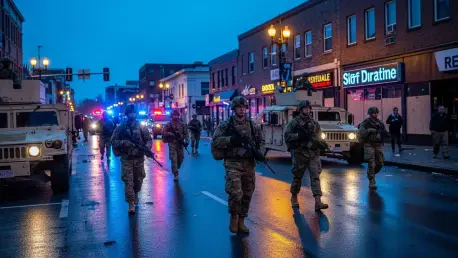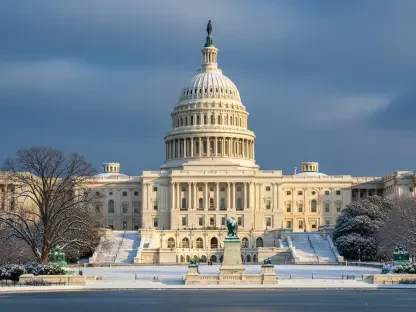What happens when the federal government steps into local streets with a heavy hand, promising safety but stirring unrest? On a crisp August morning in 2025, President Donald Trump stood in the Oval Office and declared a sweeping plan to deploy federal law enforcement to American cities, starting with Washington, D.C., and eyeing Chicago and New York next. With hundreds of agents already on the ground and arrests piling up, this move has ignited a firestorm of debate. Is this a necessary crackdown on crime, or an overreach that threatens the delicate balance between federal power and local control? The stakes couldn’t be higher as communities brace for impact.
This story matters because it cuts to the core of how safety and governance collide in a polarized nation. Trump’s assertion that federal forces will “make our cities very, very safe” clashes with data showing violent crime in places like D.C. at a 30-year low, according to a recent Justice Department report. Beyond the numbers, the deployment raises profound questions about legal authority, community trust, and the risk of escalating tensions in urban centers already navigating their own paths to security. As federal boots hit the pavement, the nation watches to see if this gamble will restore order or deepen division.
A Bold Move or a Dangerous Misstep?
The announcement on August 22 came with a tone of urgency, as Trump painted a picture of urban chaos that demanded immediate federal action. Speaking from the White House, the president vowed to tackle what he sees as rampant crime, starting with a significant presence in the nation’s capital. Yet, the decision to send hundreds of agents into cities has left many scratching their heads, given the lack of clear evidence supporting such an aggressive stance. This initial rollout sets a precedent that could reshape the relationship between federal and local powers.
Critics argue that the timing and scope of this initiative seem disconnected from reality. With violent crime rates dropping in major cities, as highlighted by federal data, the justification for such a drastic measure appears shaky at best. The concern is not just about necessity but also about the potential for overreach, as federal intervention risks undermining the autonomy of local law enforcement and elected officials who have been working on tailored solutions for their communities.
The Backdrop of Urban Safety and Federal Power
Digging deeper, the context behind this crackdown reveals a stark contrast between rhetoric and reality. Trump has repeatedly described cities like Chicago as being in a state of disarray, yet local statistics tell a different story—crime trends in many targeted areas have been on a downward trajectory. A January report from the Justice Department noted that Washington, D.C., is experiencing its lowest violent crime levels in decades, raising questions about why federal forces are being mobilized now.
This push also fits into a broader pattern of centralized control over law enforcement, a strategy that has historically sparked friction with state and municipal leaders. The tension lies in differing visions of public safety: while federal officials may see a one-size-fits-all solution, local governments often prioritize community-specific approaches. This growing divide between federal mandates and local needs is a critical piece of the puzzle, as it shapes how these deployments are perceived and resisted.
Mapping the Deployment: Scope and Legal Groundwork
The logistics of Trump’s plan are as complex as they are ambitious. In Washington, D.C., approximately 500 federal officers from agencies like the FBI, DEA, and ICE, supported by up to 2,000 National Guard soldiers, are already active. Attorney General Pam Bondi reported 719 arrests since the operation began, though clarity on whether these overlap with local police actions remains elusive. The next target is Chicago, which Trump labeled “a mess,” despite declining crime stats, with plans for New York also under consideration.
Legally, the framework for these actions varies by location. In D.C., the 1973 Home Rule Act grants federal control over the district’s police for up to 30 days, but extensions require Congressional approval—a hurdle Trump hinted he might sidestep by declaring a national emergency. Outside the capital, the legal basis for federalization is murkier, creating uncertainty about how deployments will unfold in other cities. Additionally, a proposed $2 billion in funding from Congress to “clean” D.C. signals a massive financial commitment, though specifics on allocation remain vague.
The sheer scale of this operation raises practical concerns. Coordinating multiple federal agencies with local forces is no small feat, and the risk of miscommunication or conflict looms large. As resources pour into these efforts, questions persist about whether they address root causes of crime or merely serve as a show of force, potentially alienating the very communities they aim to protect.
Voices from the Ground: Support and Pushback
Beyond policy details, the human element of this story emerges through the perspectives of those directly affected. Local leaders in Illinois and New York have been vocal in their opposition, warning that federal intervention could disrupt established safety measures and erode trust. A Chicago city official, speaking anonymously, expressed frustration, stating, “We’ve been making progress on our own terms—why impose a solution we didn’t ask for?” Such sentiments reflect a broader fear of federal overreach.
Experts also weigh in with skepticism about the efficacy of this approach. Dr. Maria Lopez, a criminologist at Georgetown University, noted, “Federal deployments often prioritize visibility over impact. Without addressing underlying issues like poverty, they’re unlikely to yield lasting results.” Meanwhile, residents in D.C., where agents are already active, report mixed feelings—some welcome the added security, while others describe an unsettling sense of being under siege. These contrasting views highlight the challenge of balancing safety with community consent.
Bridging the Gap: Navigating Federal and Local Tensions
For those watching this unfold, the clash between federal authority and local governance presents a complex dilemma, but there are ways to engage constructively. Citizens can push for transparency by demanding detailed public reports on arrest numbers, funding use, and the outcomes of federal actions. Monitoring legal developments, such as the potential declaration of a national emergency, is also crucial to understanding how far federal power might stretch in the coming months.
Communities can play a role by fostering dialogue between federal agents and local stakeholders to ensure accountability and minimize conflict. Supporting grassroots initiatives that address crime through prevention and social programs offers an alternative to heavy-handed enforcement. Staying informed through reliable sources and participating in local governance processes are practical steps for anyone seeking to influence how this situation evolves, ensuring that safety strategies reflect the needs of those most impacted.
Reflecting on a Divisive Chapter
Looking back, Trump’s decision to deploy federal forces to American cities stood as a defining moment of tension between national priorities and local realities. The stark contrast between declining crime rates and the administration’s aggressive stance revealed a disconnect that fueled heated debates. Resistance from city officials in places like Chicago and New York underscored the challenges of imposing federal will on diverse urban landscapes.
As the dust settled, the path forward hinged on finding a balance—ensuring safety without sacrificing autonomy. Communities and policymakers alike faced the task of rebuilding trust, advocating for data-driven solutions, and investing in long-term strategies over temporary shows of force. The legacy of this initiative ultimately rested on whether it sparked meaningful dialogue or deepened the divide, a question that lingered as the nation grappled with its vision for public safety.









